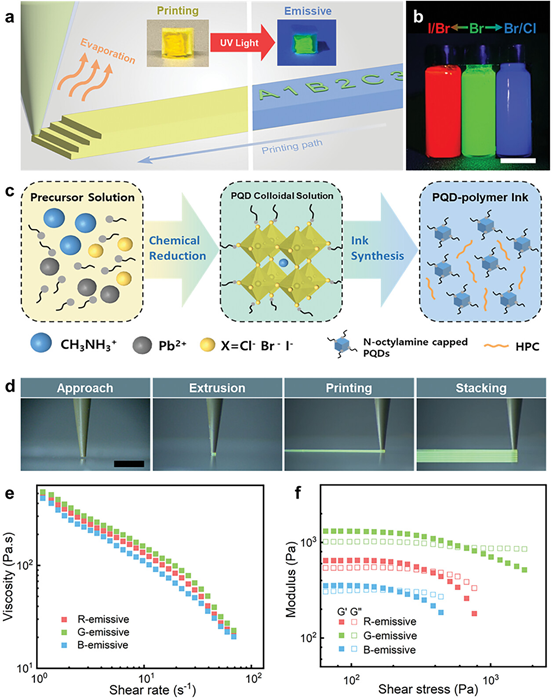In a recent study published in Advanced Functional Materials, scientists from the Department of Mechanical Engineering at UNIST developed a new 3D printing method for quantum dots (QDs) at room temperature. The method enables the development of complex 3D structures with precise light emission for advanced encryption and anti-counterfeiting applications.
 a) Schematic of the direct-ink writing (DIW) approach of luminescent PQD–polymer architectures. Hydroxypropyl cellulose (HPC) polymer was dissolved in DCM to prepare a 3D printable ink. b) Optical image of the inks as visible in 385-nm ultraviolet (UV) light. PQD–polymer inks display red (R), green (G), and blue (B) emissive colors, corresponding to the halide ratios of CH3NH3PbBr1.5I1.5, CH3NH3PbBr3, and CH3NH3PbBr1.5Cl1.5. The scale bar is 5 mm. c) Schematic of the synthesis of luminescent PQDs as a colloidal dispersion solution in toluene, including the synthesis of PQD-polymer ink with HPC. d) Optical images of the DIW process show continuous deposition of a line pattern on the glass substrate. The scale bar is 1 mm. e) Rheological property depicts a decrease in the viscosity of the ink as the shear rate increases (shear-thinning behavior). f) Solid-like inks are shifted to a liquid-like fluid as a rheological function of the shear stress. Image Credit: UNIST
a) Schematic of the direct-ink writing (DIW) approach of luminescent PQD–polymer architectures. Hydroxypropyl cellulose (HPC) polymer was dissolved in DCM to prepare a 3D printable ink. b) Optical image of the inks as visible in 385-nm ultraviolet (UV) light. PQD–polymer inks display red (R), green (G), and blue (B) emissive colors, corresponding to the halide ratios of CH3NH3PbBr1.5I1.5, CH3NH3PbBr3, and CH3NH3PbBr1.5Cl1.5. The scale bar is 5 mm. c) Schematic of the synthesis of luminescent PQDs as a colloidal dispersion solution in toluene, including the synthesis of PQD-polymer ink with HPC. d) Optical images of the DIW process show continuous deposition of a line pattern on the glass substrate. The scale bar is 1 mm. e) Rheological property depicts a decrease in the viscosity of the ink as the shear rate increases (shear-thinning behavior). f) Solid-like inks are shifted to a liquid-like fluid as a rheological function of the shear stress. Image Credit: UNIST
The study, led by Professor Im Doo Jung from UNIST's Department of Mechanical Engineering, unveiled a state-of-the-art perovskite quantum dot (PQD) additive manufacturing technique. This pioneering method eradicates the necessity for heat treatment, enabling the fabrication of intricate 3D forms with remarkable accuracy, such as renowned structures like the Eiffel Tower.
Traditionally, molding QD materials in three dimensions necessitated prolonged exposure to heat, resulting in property deterioration and shape distortion. Nonetheless, the recently devised PQD materials showcase exceptional luminous efficiency and color adaptability, presenting a revolutionary solution for cutting-edge encryption and anti-counterfeiting endeavors.
Through meticulous optimization of printing parameters and the utilization of a hydroxypropyl cellulose (HPC) polymer along with dichloromethane (DCM) as a volatile solvent, the research team achieved stable extrusion of luminescent PQD inks at room temperature. This pioneering 3D printing technique allows for the fabrication of various structures emitting light in red, green, and blue (RGB) colors, based on primary light hues.
The research presents an advanced anti-counterfeiting and encryption system employing 3D-printed geometric shapes harnessing the distinctive light emission characteristics of PQDs. Exhibiting the capability for heightened security functionalities in contemporary printed electronic devices, a 6 × 5 cube architecture array was devised utilizing G- and B-emissive PQD-HPCs for encryption, showcasing alphabetic letters (U, N, IS, and T) at 90° intervals.
Our streamlined QD 3D printing process enables stable manufacturing at room temperature, promising advancements in information encryption systems and optoelectronic printing technologies.
Hongryung Jean, Study Lead Author, UNIST
Professor Jung emphasized the significance of this research in broadening the scope of QD-based applications and bolstering anti-forgery measures, stating, “This advancement preserves the photoluminescence properties of PQDs without the need for heat treatments, driving innovation in optoelectronic and energy applications.”
This study, funded by the National Research Foundation (NRF) of Korea and other pivotal institutions, establishes a fresh benchmark for encryption technology and anti-counterfeiting measures in the digital era.
Journal Reference:
Jeon, H., et al. (2024). 3D Printing of Luminescent Perovskite Quantum Dot–Polymer Architectures. Advanced Functional Materials. doi.org/10.1002/adfm.202400594.